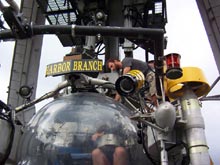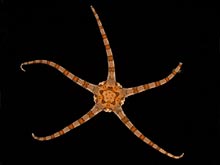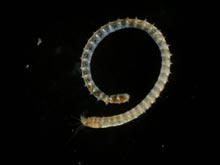
J.D. Dubick enters the Johnson-Sea-Link II for a three-hour dive to the Barrelfish Cliff dive site. Click image for larger view.
Benthic Infauna: Organisms That Live in the Sediment
August 24, 2004
Joshua D. Dubick
Marine Biology Research Technician
NOAA
National Ocean Service
![]() A
vertical wall capped by a thin layer of
manganese phosphorite rock. (mp4, 3.1 MB)
A
vertical wall capped by a thin layer of
manganese phosphorite rock. (mp4, 3.1 MB)
![]() A
North Atlantic wreckfish (Polyprion americanus)
in its natural habitat. (mp4, 3.7 MB)
A
North Atlantic wreckfish (Polyprion americanus)
in its natural habitat. (mp4, 3.7 MB)
![]() The
red bream (Beryx decadactylus)
in its natural habitat. (mp4, 4 MB)
The
red bream (Beryx decadactylus)
in its natural habitat. (mp4, 4 MB)
![]() View
a slide show of the
Young Modified Van Veen Grab sampler
in action.
View
a slide show of the
Young Modified Van Veen Grab sampler
in action.
As the R/V Seward Johnson steams inshore to pick up parts for the submersible Johnson-Sea-Link II, I am reminded of the interesting changes we hope to document as we move across the continental slope and into the depths of the ocean. One of our important expedition goals is to collect samples from the benthic (sea-floor) environment.
We collect benthic samples with both the submersible and a Young Modified Van Veen Grab sampler, or "Young Grab." The tools serve distinctive purposes. From the submersible, we collect sediment samples from very specific locations at a dive site. The Young Grab, on the other hand, is deployed from the ship. It scoops up the sea-floor sediment and organisms that live inside the top layers of the sediment, which are called "infauna."
The main groups of marine infauna we collect using these methods include polychaete worms, crustaceans (crabs and shrimp), mollusks, and echinoderms (starfish, sea urchins, sand dollars and their relatives). Following collection, the sediment sample is sieved to remove the fine sediment, and then preserved for later analysis in the lab, back on shore. In the lab, we identify and count all animals.
With this information, marine scientists can then determine the diversity and total abundance of the infauna from discrete areas of the sea floor.
Why do we care about benthic infauna? One reason is that benthic infauna are a good indicator of environmental health. Most of these animals are small; they don't travel very far during their adult lives. When they are exposed to marine pollutants (e.g., petroleum from oil spills or pesticides from river runoff), they cannot swim or crawl away fast enough to avoid the contaminants. When we collect sediment samples, we analyze a portion of the sediment to find out how much contamination is present. By correlating the measure of contaminants with the diversity and abundance of the organisms in the sediment, marine scientists are beginning to understand what constitutes a "clean" environment versus a "polluted" one. This type of information is important to those who manage and set policies for management of marine ecosystems.

A brittle star (Opheiolepis elegans) brought up from the sea-floor sediment. Click image for larger view.

An unidentified polychaete worm brought up from the sea-floor sediment. Click image for larger view.
Another measurable aspect of the benthic environment is the amount of organic carbon found in the sea-floor sediment. Known as total organic carbon (TOC), this is a measurement of the food available to benthic organisms. Usually, TOC is in higher concentrations in the nearshore environments, such as estuaries and coastal waters. The amount of organic carbon usually decreases with increasing distance from shore. This tends to create some interesting trends in diversity and abundance of benthic infauna. For example, abundances of benthic organisms decrease with increasing distance from the coast. Interestingly, the deeper waters of the continental slope (where we are sampling during this expedition) can show an increase the diversity of benthic animals, because this area is home to rare and unusual species.
We have already seen, in studies that began several years ago, some interesting patterns in the marine benthic environment. We have already sampled along the Latitude 31-30 Transect, beginning in Altamaha Sound, GA, continuing through Gray's Reef National Marine Sanctuary, and finally venturing into the pristine environments of the continental shelf edge and the continental slope. Thus, the Latitude 31-30 Transect brings us from the estuary to the abyss.
Sign up for the Ocean Explorer E-mail Update List.

























